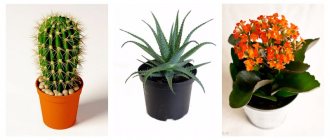Astrophytum
The name of this type of cactus is taken from the Greek language and translated means “star plant”, because, if you look at it from above, this cactus looks like a star with rays.
This species is distinguished by a variety of subspecies: some of them are without needles, and some boast rather long curly needles; Some grow quite quickly, while others need a lot of time to grow even a couple of centimeters.
Stem: strong, spherical, elongated.
Flowers: wide-opening, white or yellowish in color. They bloom at a young age.
Flowering period: 2-3 days in spring and summer.
Maintenance and care: require good lighting, tolerate direct sunlight, but prefer diffused light. They are hardy in hot weather and feel comfortable in rooms where the temperature does not exceed +28 °C.
During dormancy, it is better to keep such cacti at a temperature of +10...+12 °C. They do not require additional manipulations to humidify the air. During the growing season, astrophytums should be watered rarely (after the soil is completely dry) and so that the soil is completely saturated with water.
It is better to carry out bottom watering so that water does not fall on the plant itself. In autumn and winter, if you keep such cacti at low temperatures, you do not need to water them.
Cacti also include hathiora, epiphyllum, rhipsalis, echinocactus Gruzoni, gymnocalycium, Decembrist flower, prickly pear.
Home cactus and its care
Keeping this unpretentious plant in the house is a pleasure. There are no particular difficulties in caring for it, but like any living creature, it requires at least a little attention. Blooming cacti will appear only with caring and attentive owners.
Where to plant
The question is not fundamental. This can be everything from pots with a sliding bottom, to shoes and baking sheets. House cactus does not like tall and narrow pots. In them, its root system is at risk of rotting.
Cacti do not like tall and narrow pots
What to plant in
To make it easier to care for your cactus at home, it is better to take slightly acidic, loose, light-consistency soil. It will absorb moisture well and ventilate. You can prepare your own soil for planting using the following recipe:
1. Part of river sand.
2. Part of leaf humus.
3. Part of turf land.
Composition of soil for cacti
Absolutely all types of domestic cacti do not tolerate waterlogging of the soil, so a drainage layer must be made at the bottom of the planting container. You can fill it with gravel, expanded clay or brick chips.
How to plant
On the eve of transplantation, watering is stopped. Roots will be easier to extract from dried soil. In the new “house”, drainage is laid and a third of the volume of prepared soil is filled. The cactus is lowered into the pot, and the roots are sprinkled with the remaining soil. The root collar is hidden under a layer of river sand.
Catus planting scheme
After transplantation, watering is also not provided. You can give the plant moisture on day 4-5, when it copes with stress. Slow-growing types of house cacti can be replanted every two years. Subsequently, the transplanted cactus is cared for as standard.
Watering
A domesticated cactus needs to imitate natural habitat conditions. Watering is done rarely, but the plant is moistened abundantly. The signal for the next procedure is well-dried soil. Don't overwater your indoor cactus. Take into account the fact that the top layer of soil will dry out much faster than the middle layer and especially the bottom layer. The accumulation of moisture at the bottom of the pot is fraught with putrefactive processes in the roots.
Cacti are rarely watered
Where to put
Cacti in the interior of the room should be placed so that they have enough light and fresh air. They will feel best in spacious, sunny rooms.
The cactus prefers sunny places
Temperature
Who said cacti love the heat? Plants are fans of moderate temperatures, so don’t worry about how “foreigners” will feel in our climate. An average temperature of 18-20 degrees will suit them just fine. In winter, they also calmly fall asleep in anticipation of spring at average temperatures of 10-13 degrees. Even if the room temperature is lower, this will not harm the plants. There are even frost-resistant cacti, but in the interior of a room where heating is provided, there is no point in growing them.
The average temperature for cacti is 18-20 degrees
Air humidity
Spraying is contraindicated for domestic cacti, except Cleistocactus. In hot weather, it is better to create a draft rather than water them.
Transfer
At a young age, they need regular transplantation, then the process is carried out as needed.
Young cacti are regularly replanted
Top dressing
A cactus that is adequately cared for will definitely receive feeding. It is applied monthly, excluding winter. You can use nutritional compositions for succulents or universal fertilizers suitable for all types of indoor plants.
Aporocactus
These unusual cacti were brought to us from Mexico and from the mighty thickets on the mountain slopes they successfully turned into popular house plants.
Stem: branched into many thin stalks, the length of which can reach one meter. The ribs on such stems are not very pronounced, and the spines are bristly. At first the stems grow upward, then descend.
Flowers: tubular, their length is about 10 cm, color is pink, crimson, orange, red (depending on the specific species).
Flowering period: can bloom throughout spring.
Maintenance and care: for aporocactus, the best option is bright light without direct rays (can cause burns). Good lighting is especially important during the dormant period, since the formation of buds and abundant flowering in the future depend on light.
In spring and summer, such a plant can be placed on a terrace where there is open air, but no direct sunlight. At such times, the optimal temperature for aporocactus is +20...+25 °C. In winter, a bright, cool room would be a suitable place for the plant.
Aporocacti tolerate drought normally, but in summer it is better to spray them with warm water. In the warm season, such a flowerpot must be watered regularly, without allowing the soil to dry out completely. Watering should be from the bottom; water should not be allowed to stagnate in the pan.
In winter, you need to water less often, waiting until the soil is completely dry.
Briefly about the main thing
Cacti are plants that have adapted to harsh living conditions in deserts. In the process of evolution, the leaves of succulents turned into spines or hairs, and the stems became thicker and learned to accumulate moisture in reserve. Many types of cacti can be successfully grown at home. They decorate the interior of the house with their exotic appearance and beautiful fragrant flowers.
The wide variety of succulent species gives you plenty of choice. There are cacti with and without needles, with different stem shapes - round, columnar, cylindrical, branched. But in order to achieve a beautiful appearance and abundant flowering, it is necessary to provide the plant with the necessary conditions.
Ratings 0
Mammillaria
This type of cacti boasts a huge number of varieties and variations. Plants of the genus Mammillaria are small and can take on different shapes and colors. This genus is the most numerous in the cactus family.
Stem: spherical or cylindrical. Cone-shaped soft papillae are located in even rows on the stem. The spines are bristly, soft, thin.
Did you know? A Ukrainian collected the largest home collection of cacti in the CIS countries on the roof of his mansion.
It has more than 20 thousand plants. The total value of the collection exceeds several tens of thousands of dollars. Flowers: small (diameter - up to 2 cm), daytime. Color - pink, yellow, white, cream, pink-white. When such a cactus blooms, a “crown” of flowers forms on top of the stem.
Flowering period: the genus Mammillaria is considered to be a rare flowering species.
As a rule, flowers appear in early spring. Maintenance and care: these cacti love light, but what kind of light depends on how pubescent the plant is. Unlike non-pubescent cacti, which do not tolerate direct sunlight well, pubescent cacti need to receive a large amount of direct light.
Well-lit areas are also loved by begonia, syngonium, daylily, sedum, alstroemeria, pedilanthus, streptocarpus, leucanthemum cornflower, cordyline, caladium, and fuchsia.
In summer, the suitable temperature is about +25 °C, in winter - +10...+12 °C for green species and +15 °C for pubescent ones. In very hot times, the plant can be sprayed. Like other cacti, mammillaria do not like the soil to be waterlogged, so such a pot should be watered infrequently.
In winter, when the plant is kept in a cool room, there is no need to water it at all.
Breeding
The most convenient way to grow cacti at home is vegetatively. Many cacti produce so-called babies.
The baby, 2-2.5 cm in size, is carefully separated from the mother plant and the lower part is buried in wet sand. To prevent the soil from drying out quickly, you need to put a transparent bag on the pot.
The soil should be sprayed as necessary. Usually after 6-7 days root formation begins. when the roots grow by 0.5 - 0.7 mm, the baby can be transplanted into a permanent pot.
Prickly pear can be propagated by cuttings, separating them in a narrow place. The cuttings need to be air-dried for two days, and then proceed in the same way as with the baby.
There are cacti that do not give birth to children. In this case, they can be propagated by seeds. It is most convenient to buy seeds in a special store or obtain them from private collections. Propagation by seeds is a painstaking process. It is important to use absolutely sterile substrate, bowls and other material. Seedlings of young cacti are very often affected by fungi and die.
Seed germination is carried out at a daytime temperature of + 25 + 26 degrees and at + 18 + 20 degrees at night. For this it is convenient to use a small greenhouse. Sowing is done superficially, lightly sprinkling the seeds with soil. After the seedlings emerge, the seedlings should be kept in a lighted place and watered by spraying, so that there are no large splashes, but a fine water mist is formed. Twice a day, the cover from the greenhouse must be removed and the young plants ventilated.
Tip: Bottom heating of the greenhouse will help speed up germination. You can use thermal mats for this.
After the seedlings reach a size of 15 - 20 mm, they can be transplanted into permanent pots. We will try to tell you how to properly transplant a young or adult “thorn”.
Rebutia
This cactus is one of the most common plants in the world and a very popular indoor plant that attracts more and more gardeners every year.
Stem: These flowering indoor cacti have a round, fleshy stem with a dimple at the top, covered with spiraling ridges and short, stiff spines that are silvery or yellowish in color.
Flowers: diurnal, have elongated tubes of glossy petals that are fused, and are about 2.5 cm in diameter. Flowers can be cream, pink, purple or scarlet.
Flowering period: about two days in April-June.
Maintenance and care: they are not afraid of direct sunlight when the room where the cactus is located is well ventilated, they feel comfortable at temperatures from +5 °C to +25 °C and are well adapted to sudden temperature changes. It is necessary to water rarely, waiting until the soil dries well.
Varieties of home cacti
Many varieties of this family can be grown at home, but most of them are not suitable for indoor cultivation due to their size. Preference is given to prickly pears and astrophytums, since they are ideal for growing in pots or floor vases.
When choosing indoor cacti, pay attention to the spines, which in many varieties appear only in adulthood. They pose a danger to children and many pets.
In phyto-decoration of a room today, compositions from different varieties of cactus are used. Such florariums can be created from varieties that differ in shape and length, placing the shorter ones at the front edge and the tall ones in the center of the composition.
To choose them perfectly, you need to know the varieties with names and main characteristics.
Mammillaria
An unpretentious home cactus of small size, blooming beautifully. Comes from Mexico, Colombia, USA. Shape – disc-shaped, round, oblong, spherical. It has no ribs and is covered with tubercles - they protect the trunk from rays and retain moisture. The roots are fleshy and thick.
The lower part is covered with fairly hard spines, with pubescence and buds on top. These flowers come in yellow, red or white shades, do not exceed 7 mm in diameter, and form fruits with small black seeds.
There are several varieties of mammillaria:
- Carmen;
- Blossfeld;
- Bokasana;
- Wilda;
- Zeilman;
- Bouma;
- Parkinson's.
Almost all of them have a spherical shape and small buds. Some varieties may have buds of different colors on the same plant.
Ariocarpus
An unusual thornless cactus, identified as a separate genus in 1838 by Joseph Scheidweller. The inconspicuous, flattened stems, which more closely resemble sharp stones, are collected in a dense bunch. The bright flower makes this variety particularly decorative. There are at least 6 of them at the top of the cactus, they are bright red with a yellow core. Also, the buds can be white, yellow, light pink, peach.
It lives in America at an altitude of up to 2.5 km. The turnip (pear) shaped root is large and can occupy up to 75% of the weight. It contains a lot of moisture, which helps the cactus survive drought. The root is flat, flattened to the soil. Thorns are rare; more often, on the surface of the stems there are hard endings, hard, blunt, up to 5 cm. The skin is smooth from light green to bluish.
The pulp of the stem constantly produces a thick mucus, which is used as glue by local residents of America. It blooms from September to October, then oval or spherical red or white fruits up to 2.5 cm in diameter are formed.
Has several subspecies:
- agave;
- dull;
- cracked;
- flaky;
- intermediate;
- Kochubey.
Some varieties, notably Ariocarpus flaky, look more like stone or driftwood without the flower.
Gymnocalycium
Succulents, uniting up to 80 subspecies, most of which are grown indoors. In the natural environment, they are common in Argentina, Brazil, Bolivia, and Paraguay.
It looks like a spherical flattened stem up to 15 cm in diameter. Its color is gray-green, brownish. Selected varieties may have yellow or red stems. Flowers vary in shape and can look like white buds or crimson balls. The size of the stem can vary from 2 to 30 cm, the flowers are located on top and have an elongated tube. The first buds appear from the age of three in the spring.
There are varieties with thorns, the bases of which are covered with fluff. Some varieties, especially flattened ones, have several spines located on the ribs, without a fluff.
Cleistocactus
Non-thorny succulents from the cactus family. The stems are columnar, erect or drooping, soft, dotted with needles, densely located throughout the entire area of the shoots. They come from Latin America, where they cover large areas of land. Also grown as an ornamental plant. In this case, they reach a height of 40 cm.
The stems are almost ideally cylindrical in shape, up to 10 cm in diameter. The ribs are inexpressive, from 15 to 20 pieces on one stem. The bristles-spines are scattered chaotically and are white, red, gray or yellow.
It blooms with attractive pink or reddish buds. The fruit is large, round or oblong in shape and bright in color. Covered with a bristly glossy skin, inside there is juicy whitish pulp containing small black seeds.
There are several types:
- Strauss;
- Winter;
- emerald;
- Tupian;
- Ritter.
Some varieties have creeping shoots up to 1 m in height and only 2.5 cm in diameter. Their color is light green, the spines are so thin that they look more like pubescence.
Lophophora
The second name for this succulent is peyote. Significantly different from other cacti. Unites up to 4 species, grows spherical, as if divided into equal parts. It grows naturally in the USA and Mexico, hiding in bushes and on low mountain slopes.
Cereus
The name of this variety of cacti in Latin sounds like “Cereus”, and translated means “wax candle”. Such cacti are long-lived in the plant world. In natural conditions, Cereus is a giant plant that can grow up to 20 meters in height. For home cultivation, more compact subspecies of Cereus are chosen.
Stem: rough with pronounced ribs. Depending on the subspecies, it can be smooth or covered with sharp long needles.
Flowers: large white, arranged laterally. Some subspecies boast a pleasant vanilla aroma.
Important! “Pampering” the cactus (too spacious a pot, too frequent watering and fertilizing) can cause a lack of flowering.
Flowering period: late spring - early summer, at night. They bloom 24 hours after opening.
Maintenance and care: in order for such a flowerpot to feel comfortable at home and bloom, it needs good light and long daylight hours.
These plants love direct sunlight, but in summer they must be protected from burns. To prevent direct light from harming the plant in spring or summer, it is necessary to accustom the cereus to it immediately after winter ends. As for temperature, in winter, when the cactus has a dormant period, the optimal temperature for it is +8...+12 °C.
At any other time, the cereus is unpretentious, calmly tolerates heat and sudden temperature changes.
It is necessary to water with warm water, more often in summer, then reduce the frequency of watering. Do not over-water the plant: it can get sick and rot.
Features of growing cacti at home
Cacti in the wild are found primarily in deserts and are able to survive in extreme conditions. They tolerate drought, temperature changes, and bright sunlight well. All cacti can be classified as succulent plants. Cacti are able to accumulate liquid in their tissues and use it when a dry period occurs.
Such plants successfully survive in conditions of temperature changes up to 40 degrees, lack of moisture and infertile sandy or rocky soil.
Cactus in the wild Source mandarin-shop.ru
Most varieties of cacti have long been cultivated, and there are a large number of hybrids that are not adapted to life in nature. Decorative cacti can be combined into various compositions.
Even an inexperienced gardener can achieve active growth and lush flowering, since cacti do not need to be regularly watered, pruned, replanted or sprayed. At the same time, do not forget about protection when working with succulents. To do this, you need to use gloves or wrap the stem with old newspapers.
You won’t be able to pick up this succulent without protection Source autogear.ru
It is also worth taking into account that the most beautiful cacti for the home are quite expensive. To create a composition, you can use different types of plants, and mature and expensive specimens should be used as the center of the composition or as a single plant.
Absolutely all types of cacti bloom in natural conditions. But on the windowsill or in the winter garden, flower buds are produced mainly by the following species: Cereus, Chamecereus, Mammillaria, Frailea, Echinopsis, Epiphyllum, Rebutia, Phyllocactus, Wiloxia, Astrophytum, Zygogcactus. It is much easier to create favorable conditions for these types of plants. It is also worth remembering that some types of succulents emit a rotten meat aroma when flowering. This is especially true for forest cacti.
Many succulents delight not only with their beautiful appearance, but also with their abundant flowering Source pro2-bar-s3-cdn-cf1.myportfolio.com
Rhipsalis
“Rhips” - the word from which the name of this species comes, translated from Greek means “braid”, which very accurately characterizes the appearance of this plant.
Stem: can be different: ribbed, rounded, flattened. As a rule, there is not one stem, but many curly hanging stems without thorns grow from one pot, which is the main difference between this species and others.
Flowers: small, delicate, bell-like in pink, white, yellow or bright red.
Flowering period: several days in spring and summer.
Maintenance and care: representatives of this type of cacti prefer bright, diffused light and can grow in the shade. In summer, you can place a pot with a plant on the veranda or in the yard, but so that direct rays do not fall on it.
For this type of cacti, the comfortable temperature in spring and summer is +18...+20 °C, in winter - +12...+16 °C. Such cacti are not sensitive to air humidity, but in summer they need to be sprayed with warm infused water.
During the growing season, the plant should be watered regularly, when the top layer of soil dries out; in the fall, watering should be reduced, and in winter, watering should be done very rarely.
Echinopsis
Echinopsis is no different from most types of flowering cacti, which get their names due to their external features. “Echinos” means “hedgehog” in Greek, and this name fits perfectly all representatives of this species.
Stem: first has a spherical shape, then stretches out and takes the shape of a cylinder. The color can be either bright green or dark. The ribs are even and clearly expressed. The size and density of the spines differs depending on the specific subspecies.
Flowers: large (diameter - about 14 cm), funnel-shaped, pink, white, yellow or orange, grow on a pubescent tube, the length of which can reach 20 cm.
Flowering period: 1-3 days in spring.
Maintenance and care: they love bright light, tolerate direct sunlight. Comfortable temperature in summer is from +22 °C to +27 °C, in winter - from +6 °C to +12 °C. In spring and summer, it should be watered a few days after the soil under the plant has completely dried out. During the dormant period (winter), you can not water it at all or do it very rarely. They do not need spraying even in summer.
Classification of cacti
Cacti are divided into four subfamilies, which are divided into species. The subfamily unites species of domestic cacti, similar in appearance and growing conditions.
By appearance
Varieties of cacti that differ in appearance:
- Tree-like plants have a characteristic appearance - one or more erect stems with lateral shoots resembling branches. These are the largest representatives of the family; the height of many specimens reaches 20-30 m in natural growing conditions.
- Herbaceous plants grow on plains in heavy soils. This group is characterized by less massive stems, usually thin, light or dark green with indistinct spines or pubescence.
- Shrubs are the most primitive forms of cacti that grow in savannas. They have ordinary leaves, abundant flowering, and short shoot length. A cactus with leaves can resemble a small bush or indoor flower.
- Liana (ampeloid forms) have soft flexible long stems. Epiphytic plants are most often found in this group. They throw stems onto nearby plants, trees, bushes, walls, rock ledges, completely entwining them.
Tree and shrub species are practically not grown indoors, only when bred as bonsai.
By place of growth
The cactus family mainly grows in hot desert conditions, and also settles on mountain slopes and plains. Depending on climatic conditions, they take different forms - tree-like, herbaceous, vines or shrubs. But all species are characterized by a high degree of adaptability to the environment, which is why their shape and size change.
Echinopsis
Echinopsis exists in the wild in the form of balls or ovals with countless spines. Over time, the round shape becomes columnar or oval. The stem has from two to four ribs, smooth, green. The variety has a branched powerful root system, which is localized horizontally in the upper layers of the earth.
Along the surface of the ribs in the halos there are hard spines, the length of which varies depending on the species. The flowers appear mainly in the middle part of the stem on the sides, reaching 15 cm in diameter, the flower tube is drooping. Color varies from white to purple. Smooth black seeds up to 2 mm in diameter appear from the resulting ovoid fruits.
Cacti of the genus Echinopsis are most common in southern Argentina, Bolivia, Brazil, Uruguay and the foothills of the Andes.
prickly pear
Opuntia is distinguished by its diversity of species; today there are at least 190 of them. This genus is the largest in the cactus family, widespread in America and Mexico. The fruits and shoots are used for food; soap is made from the trunks and the dye carmine is extracted. In some countries, prickly pear is used as livestock feed. Some neophyte species are so aggressive that they behave like weeds.
Epiphyllum
Epiphyllums are cacti with a shrubby growth form and a woody base.
Wisteria, spirea, aichrizona, cercis, mountain pine, dieffenbachia, bladderwort, aster, and cinquefoil also boast a shrub growth form.
The name of the species consists of two Greek words: “epi” - “above” and “phyllum” - “leaf”. This plant was unofficially nicknamed “orchid cactus” for its extraordinary beauty.
Stem: leaf-shaped, fleshy, serrated.
Flowers: appear on modified stems - cactus leaves. Funnel-shaped, quite large in size, have a long tube and a pleasant aroma. Color: white, cream, yellow, pink, red.
Flowering period: spring, the flower disappears 5 days after it blooms.
Important! You should not change the location of the plant when the buds begin to appear, because they may fall off and the flowerpot will not bloom.
Maintenance and care: epiphyllum benefits from receiving a large amount of diffused light. In summer, you can take the flower outside, but place it where it will not receive direct sunlight.
The optimal temperature in spring and summer can range from +20 °C to +26 °C.
When the plant enters a dormant period, the comfortable temperature is from +10 °C to +15 °C. On hot summer days it is recommended to spray it with warm water. Because epiphyllum is a species of rainforest cactus, it needs watering much more often than those cacti that come from dry areas.
To water it, you don’t have to wait until the soil in the pot is completely dry; it is necessary that it is always moist, and only the top layer dries out. While the cactus is blooming, it can be fertilized.
Transfer
How to plant a cactus: examples at home
The cactus requires replanting when the previous pot becomes too small for it. It is better to do this with the onset of spring or summer, during the period of active growth, except for flowering. Also, a recently purchased flower must be replanted and the soil replaced, but this can only be done after 10-12 days to allow it to acclimatize to the new conditions.
Note! The frequency of replanting depends on the variety, age of the cactus and the occurrence of pests.
To prepare for replanting, a few days before, you need to stop watering and spraying the plant so that the soil dries well. Then, tapping on the walls of the pot, carefully pull out the cactus using tweezers. You can also wrap the flower in several layers of paper and carefully shake it out of the pot.
After this, you need to knead the earthen lump remaining on the roots. If the substrate does not crumble easily from the roots, you can soak them in warm water.
Cactus roots
After cleaning, the roots are carefully inspected and, if damaged parts are found, cut off. For additional prevention, the root system can be immersed in water at a temperature of 60 ºC for 15-20 minutes, then dried well for a couple of days.
Once the required pot has been selected, you can begin the transplanting process.
Note! The pot should be large enough to accommodate the root system, but not too large and not leave a lot of extra space.
A drainage layer of 3-5 cm is laid out at the bottom of the pot, and a small amount of prepared substrate is poured on top. After this, the cactus is carefully lowered into the pot, the roots are straightened and the soil mixture is poured. The root collar of the plant should not be covered with soil, remaining above its level. During the planting process, the substrate needs to be compacted a little, as a result of which it should be 1 cm below the level of the container.
The first few days after transplantation, the flower must undergo acclimatization in the new conditions. You should not place it on a windowsill where the bright sun shines; it is better to leave it in a shaded place. You can water the plant after 5-7 days. The water should be moderately warm (temperature 32-35 ºС). If after watering the soil layer settles, you can add a little more substrate to the pot.
Cactus babies
If the transplant took place in winter, then the first watering should be done no earlier than 2-3 weeks. The room temperature should be 20-25 ºС. Fertilizer application is possible a month after transplantation. For this purpose, mineral complexes containing potassium, phosphorus, nitrogen and microelements are used.
For your information! Reproduction of cacti occurs using seeds, which is very time-consuming and labor-intensive, and flower shoots. Cactus babies have barely noticeable roots that take root in the ground in the same way as adult flowers.
If the question arises of how to plant a cactus, you can safely apply the transplanting rules described above.
Notocactus
The name of this type of cacti translated from Greek means “southern cactus”, since it was in this part of the globe that they appeared.
Stem: spherical or wedge-shaped with well-defined ribs and a large number of spines.
Flowers: Can be of different sizes, depending on the species. The color is usually yellow or yellow-violet.
Flowering period: spring or summer, depending on the subspecies, the flower can remain open for more than 5 days.
Maintenance and care: needs bright, diffused lighting. The temperature during the growing season is up to +26 °C, in winter - not lower than +10 °C. The plant must be watered abundantly from March to September and moderately from October to March. The soil should not be allowed to dry out completely. At the same time, it is not good if it is over-moistened.
Popular types of indoor cacti
Hundreds of varieties of cacti are suitable for growing at home, but many of them are of interest only to collectors, as they are either devoid of decorative value or difficult to cultivate. We decided to focus on only a few types, the most popular among ordinary gardeners.
Gymnocalycium
Representatives of this species have spherical or cylindrical stems, the size of which can vary greatly. They belong to flowering plants. The first flowers appear already in the 2-3rd year of the plant’s life. The flowers have bare tubes, the petals can be of different shades: from delicate white to magical dark purple. If your attention is drawn to a cactus with a yellow or red stem (as in the photo), then you are most likely admiring a Gymnocalycium. This happens due to the lack of chlorophyll in the stem. This type of indoor cacti attracts the attention of gardeners due to its increased decorativeness: it looks bright and completely unusual, even when it is not blooming.
Gymnocalycium
Ariocarpus
The spines of this cactus are reduced, the stem has triangular branches, sometimes resembling leaves. Often looks flattened. Outside the flowering period it is not very decorative, but every autumn a magnificent flower blooms at its top. For the sake of such a reward, flower growers breed this type of cacti at home.
Ariocarpus
Cleistocactus
It has a cone-shaped stem, which in nature can reach 4 meters. At home, it grows to about 30-50 cm. The trunk is covered with thin spines, which is why the cactus appears fluffy. If you decide to plant this cactus at home, prepare a large pot for it - the plant has a developed root system.
Cleistocactus
Astrophytum
Cacti of this species are almost all devoid of spines or covered with a small number of them. From above they may resemble stars, since the stem is divided into pronounced edges. Another distinctive feature of the plant is the light “pimples” that cover the stem randomly or in the form of a specific pattern. Astrophytum grows slowly, but blooms with beautiful yellow or red flowers.
Astrophytum
Mammillaria
A very common type of cactus. There are even clubs for mammillaria lovers. Despite the fact that the flower is capricious and requires a lot of light and heat, flower growers in different countries of the world willingly grow this plant at home. During flowering, these cacti are covered with buds that resemble a hoop or crown. This plant has many areoles and they have an unusual shape. Unlike other types of cacti, the flowers of mammillaria do not appear from the areoles, but from the axils located between them.
Mammillaria
Cephalocereus
You may have heard the Russian name for this type of cacti – “the head of an old man.” Looking at the photo, you will immediately understand why this flower was so nicknamed and how it differs from other types of cacti.
Cephalocereus
Rhipsalis
Belongs to epiphytes. Its homeland is the tropics, which means its care requirements are not the same as most other desert cacti. Similar to hanging plants. It has small roots that are attached to the support. It blooms quickly but abundantly: a flower blooms in almost every areole. Then, at the place of flowering, fruits similar to currant berries are formed.
Rhipsalis
Zygocactus
Among Russian plant growers, the plant is known as “Decembrist”. An epiphyte that blooms in the cold season. Some other types of epiphytes are known under the same name.
Zygocactus
Epiphyllum
Outwardly it is similar to other types of epiphytes, but it blooms in September and May, and its flowers are larger and more decorative than those of the same “Decembrist”. To admire this miracle, the plant must be properly cared for and generously fertilized. Sometimes this flower is called “Easter”.
Epiphyllum
Rebutia
One of the most unpretentious and common types of cacti. Has the shape of a ball. With proper care (and even in spartan conditions) it grows well, becoming covered with more and more new balls. If the plant is provided with good and, most importantly, correct care, it can bloom.
Rebutia
Notocactus
May be spherical or cylindrical. Blooms from March to July. Depending on the variety, it has either yellow, pink or purple flowers. Less commonly, notocactus flowers have other shades. Flowering begins in the fourth year and becomes regular. The plant can be propagated by seeds.
Notocactus











